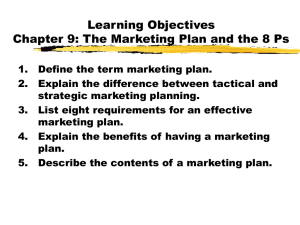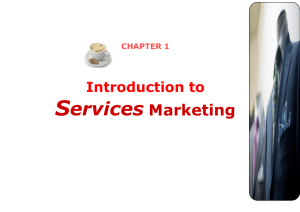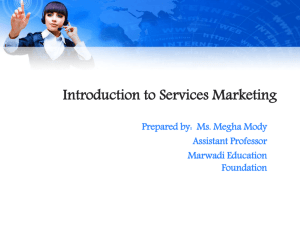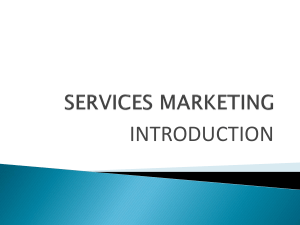Services 1
advertisement
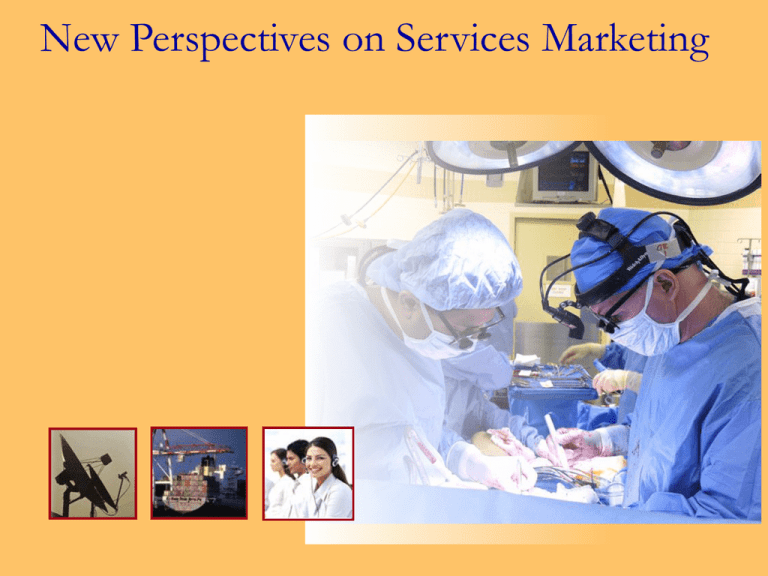
New Perspectives on Services Marketing Overview of Session Why Study Services? What are Services? The Marketing Challenges Posed by Services The Expanded Marketing Mix Required for Services Why Study Services? Why Study Services? (1) Services dominate economy in most nations Understanding services offers you personal competitive advantages Importance of service sector in economy is growing rapidly: Services account for more than 60 percent of GDP worldwide Almost all economies have a substantial service sector Most new employment is provided by services Strongest growth area for marketing Service Sector Contribution to Indian Economy In the Year 2010 the contribution of different sectors was: Services: 58.4% Industry: 24.1% Agriculture: 17.5% NAICS: A New Way to Classify and Analyze the Service Economy NAICS—North American Industry Classification System— now used to compile and record economic data by national statistical agencies of the U.S., Canada, Mexico New classification system replaces old SIC (Standard Industrial Classification) codes in U.S. Captures huge array of new service industries, each with its own NAICS code NAPCS—North American Product Classification System— assigns codes to thousands of service products Particularly useful for looking at rented goods services U.S. and Canadian data easily accessible on the Web; information includes number of establishments and employment Some Newer Service Industries Profiled by NAICS Codes But Not SIC Casino Hotels HMO Medical Centers Continuing Care Retirement Communities Industrial Design Services Diagnostic Imaging Centers Investment Banking and Securities Dealing Diet and Weight Reducing Centers Management Consulting Services Environmental Consulting Satellite Telecommunications Golf Courses, Country Clubs Telemarketing Bureaus Hazardous Waste Collection Temporary Help Services Why Study Services? (2) Most new jobs are generated by services Fastest growth expected in knowledge-based industries Significant training and educational qualifications required, but employees will be more highly compensated Will service jobs lost to lower-cost countries? Yes, some service jobs can be exported Changing Structure of Employment as Economic Development Evolves Agriculture Services Industry Time, per Capita Income Source: IMF, 1997 Why Study Services? Powerful forces are transforming service markets Government policies, social changes, business trends, advances in IT, internationalization These forces are reshaping Demand Supply The competitive landscape Customers’ choices, power, and decision making Transformation of the Service Economy Social Changes Business Trends Advances in IT Government Policies Globalization New markets and product categories Increase in demand for services More intense competition Innovation in service products & delivery systems, stimulated by better technology Customers have more choices and exercise more power Success hinges on: Understanding customers and competitors Viable business models Creation of value for customers and firm Factors Stimulating Transformation of the Service Economy (1) Social Changes Business Trends Advances in IT Government Globalization Policies Changes in regulations Privatization New rules to protect customers, employees, and the environment New agreement on trade in services Factors Stimulating Transformation of the Service Economy (2) Social Changes Business Trends Advances in IT Government Policies Globalization Rising consumer expectations More affluence More people short of time Increased desire for buying experiences versus things Rising consumer ownership of high tech equipment Easier access to information Immigration Growing but aging population Factors Stimulating Transformation of the Service Economy (3) Social Changes Business Trends Advances in IT Government Globalization Policies Push to increase shareholder value Emphasis on productivity and cost savings Manufacturers add value through service and sell services More strategic alliances and outsourcing Focus on quality and customer satisfaction Growth of franchising Marketing emphasis by nonprofits Factors Stimulating Transformation of the Service Economy (4) Social Changes Business Trends Advances in IT Government Globalization Policies Growth of the Internet Greater bandwidth Compact mobile equipment Wireless networking Faster, more powerful software Digitization of text, graphics, audio, video Factors Stimulating Transformation of the Service Economy (5) Social Changes Business Trends Advances in IT Government Globalization Policies More companies operating on transnational basis Increased international travel International mergers and alliances “Offshoring” of customer service Foreign competitors invade domestic markets What Are Services? What Are Services? (1) The historical view Goes back over 200 years to Adam Smith and Jean-Baptiste Say Different from goods because they are perishable (Smith 1776) Consumption cannot be separated from production, services are intangible (Say 1803) A fresh perspective: Services involve a form of rental, offering benefits without transfer of ownership Include rental of goods Marketing tasks for services differ from those involved in selling goods and transferring ownership What Are Services? (2) Five broad categories within non-ownership framework: 1. 2. 3. 4. 5. Rented goods services Defined space and place rentals Labor and expertise rentals Access to shared physical environments Systems and networks: access and usage Implications of renting versus owning (Service Perspectives 1.1) Markets exist for renting durable goods rather than selling them Renting portions of larger physical entity (e.g., office space, apartment) can form basis for service Customers more closely engaged with service suppliers Time plays central role in most services Customer choice criteria may differ between rentals and outright purchases Services offer opportunities for resource sharing Defining Services Services Are economic activities offered by one party to another Most commonly employ time-based performances to bring about desired results in: ― recipients themselves ― objects or other assets for which purchasers have responsibility In exchange for their money, time, and effort, service customers expect to obtain value from Access to goods, labor, facilities, environments, professional skills, networks, and systems But they do not normally take ownership of any of the physical elements involved Service Products versus Customer Service and After-Sales Service A firm’s market offerings are divided into core product elements and supplementary service elements Is everyone in service? Need to distinguish between: Marketing of services Marketing goods through added-value service Good service increases the value of a core physical good After-sales service is as important as pre-sales service for many physical goods Manufacturing firms are reformulating and enhancing existing added-value services to market them as standalone core products Challenges Posed by Services Services Pose Distinctive Marketing Challenges Marketing management tasks in the service sector differ from those in the manufacturing sector The eight common differences are: 1. 2. 3. 4. 5. 6. 7. 8. Most service products cannot be inventoried Intangible elements usually dominate value creation Services are often difficult to visualize and understand Customers may be involved in co-production People may be part of the service experience Operational inputs and outputs tend to vary more widely The time factor often assumes great importance Distribution may take place through nonphysical channels What are marketing implications? Differences, Implications, and Marketing-Related Tasks Difference Most service products cannot be inventoried Intangible elements usually dominate value creation Services are often difficult to visualize and understand Customers may be involved in coproduction Implications Customers may be turned away Harder to evaluate service and distinguish from competitors Greater risk and uncertainty perceived Interaction between customer and provider; but poor task execution could affect satisfaction Marketing-Related Tasks pricing, promotion, and Use reservations to smooth demand; work with ops to manage capacity Emphasize physical clues, employ metaphors and vivid images in advertising Educate customers on making good choices; offer guarantees Develop user-friendly equipment, facilities, and systems; train customers, provide good support Differences, Implications, and Marketing-Related Tasks Difference People may be part of service experience Operational inputs and outputs tend to vary more widely Implications Behavior of service personnel and customers can affect satisfaction assumes great importance Distribution may take place through nonphysical channels Recruit, train employees to reinforce service concept Shape customer behavior Hard to maintain quality, Redesign for simplicity and Difficult to shield Time is money; Find ways to compete on consistency, reliability customers from failures Time factor often Marketing-Related Tasks customers want service at convenient times Electronic channels or voice telecommunications failure proofing Institute good service recovery procedures speed of delivery; offer extended hours Create user-friendly, secure websites and free access by telephone Value Added by Physical, Intangible Elements Helps Distinguish Goods and Services Physical Elements High Salt Detergents CD Player Wine Golf Clubs New Car Tailored clothing Fast-Food Restaurant Low Source; Adapted from Lynn Shostack Plumbing Repair Health Club Airline Flight Landscape Maintenance Consulting Life Insurance Internet Banking Intangible Elements High Progressive and REI: Two Types of Website Reflecting Core Product Websites can deliver info-based services like Progressive’s car insurance but … …REI’s camping gear must be delivered through physical channels to customers after they have used the website to make choices, order, and pay Expanded Marketing Mix for Services Services Require An Expanded Marketing Mix Marketing can be viewed as: A strategic and competitive thrust pursued by top management A set of functional activities performed by line managers A customer-driven orientation for the entire organization Marketing is the only function to bring operating revenues into a business; all other functions are cost centers The “8Ps” of services marketing are needed to create viable strategies for meeting customer needs profitably in a competitive marketplace The 8Ps of Services Marketing Product Place and Time Price and Other User Outlays Promotion and Education Process Physical Environment People Productivity and Quality Fig 1.9 Working in Unison: The 8Ps of Services Marketing The 8Ps of Services Marketing: (1) Product Elements Embrace all aspects of service performance that create value Core product responds to customer’s primary need Array of supplementary service elements Help customer use core product effectively Add value through useful enhancements Planning marketing mix begins with creating a service concept that: Will offer value to target customers Satisfy their needs better than competing alternatives The 8Ps of Services Marketing: (2) Place and Time Delivery decisions: Where, When, How Geographic locations served Service schedules Physical channels Electronic channels Customer control and convenience Channel partners/intermediaries The 8Ps of Services Marketing: (3) Price and Other User Outlays Marketers must recognize that customer outlays involve more than price paid to seller Traditional pricing tasks: Selling price, discounts, premiums Margins for intermediaries (if any) Credit terms Identify and minimize other costs incurred by users: Additional monetary costs associated with service usage (e.g., travel to service location, parking, phone, babysitting, etc.) Time expenditures, especially waiting Unwanted mental and physical effort Negative sensory experiences The 8Ps of Services Marketing: (4) Promotion and Education Informing, educating, persuading, reminding customers Marketing communication tools Media elements (print, broadcast, outdoor, retail, the Internet, etc.) Personal selling, customer service Sales promotion Publicity/PR Imagery and recognition Branding Corporate design Content Information, advice Persuasive messages Customer education/training The 8Ps of Services Marketing: (5) Process How firm does things may be as important as what it does Customers often actively involved in processes, especially when acting as co-producers of service Process involves choices of method and sequence in service creation and delivery Design of activity flows Number and sequence of actions for customers Nature of customer involvement Role of contact personnel Role of technology, degree of automation Badly designed processes waste time, create poor experiences, and disappoint customers The 8Ps of Services Marketing: (6) Physical Environment Design servicescape and provide tangible evidence of service performances Create and maintain physical appearances Buildings/landscaping Interior design/furnishings Vehicles/equipment Staff grooming/clothing Sounds and smells Other tangibles Manage physical cues carefully— can have profound impact on customer impressions The 8Ps of Services Marketing: (7) People Interactions between customers and contact personnel strongly influence customer perceptions of service quality The right customer-contact employees performing tasks well Job design Recruiting Training Motivation The right customers for firm’s mission Contribute positively to experience of other customers Possess—or can be trained to have— needed skills (co-production) Can shape customer roles and manage customer behavior The 8Ps of Services Marketing: (8) Productivity and Quality Productivity and quality must work hand in hand Improving productivity key to reducing costs Improving and maintaining quality essential for building customer satisfaction and loyalty Ideally, strategies should be sought to improve both productivity and quality simultaneously—technology often the key Technology-based innovations have potential to create high payoffs But, must be user friendly and deliver valued customer benefits Marketing Must Be Integrated with Other Management Functions Marketing Must Be Integrated with Other Management Functions Three management functions play central and interrelated roles in meeting needs of service customers Operations Management Marketing Management Customers Human Resources Management A Framework for Developing Effective Service Marketing Strategies A Framework For Developing Effective Service Marketing Strategies: Overview Understanding Customer Needs, Decision Making, and Behavior in Service Encounters Building the Service Model Managing the Customer Interface Implementing Profitable Service Strategies Framework for Developing Effective Service Marketing Strategies: Part I I: Understanding Customer Needs, Decision Making, and Behavior in Service Encounters Differences among Services Affect Customer Behavior Three-Stage Model of Service Consumption Prepurchase Stage: Search, evaluation of alternatives, decision Service Encounter Stage: Role in high-contact vs. low-contact delivery Post-Encounter Stage: Evaluation against expectations, future intentions Framework for Developing Effective Service Marketing Strategies: Part II Building The Service Model Part II: Chapters 3-7 The Value Proposition Develop service concept: core & supplementary elements Select physical & electronic channels for service delivery Value Exchange Set prices with reference to costs, competition & value The Business Model Educate customers & promote the value proposition Position the value proposition against competing alternatives Framework for Developing Effective Service Marketing Strategies: Part III III: Managing the Customer Interface Design and manage service processes Balance demand against productivity capacity Plan the service environment Manage service employees for competitive advantage Framework for Developing Effective Service Marketing Strategies: Part IV IV: Implementing Profitable Service Strategies Create customer relationship and build loyalty Plan for service recovery and create customer feedback systems Continuously improve service quality and productivity Organize for change management and service leadership Improving Service Quality and Productivity Overview of Session Integrating service quality and productivity strategies What is service quality? The Gaps Model—a conceptual tool to identify and correct service quality problems Measuring and improving service quality Integrating Service Quality and Productivity Strategies Integrating Service Quality and Productivity Strategies Quality and productivity are twin paths to creating value for both customers and companies Quality focuses on the benefits created for customers; productivity addresses financial costs incurred by firm Importance of productivity: Keeps costs down to improve profits and/or reduce prices Enables firms to spend more on improving customer service and supplementary services Secures firm’s future through increased spending on R&D May impact service experience—marketers must work to minimize negative effects, promote positive effects What Is Service Quality? Different Perspectives of Service Quality Transcendent: Quality = Excellence. Recognized only through experience Product-based: Quality is precise and measurable User-based: Quality lies in the eyes of the beholder Manufacturing- Quality is in conformance to the firm’s developed based: specifications Value-based: Quality is a trade-off between price and value Components of Quality: Service-based (SERVQUAL) Tangibles: Appearance of physical elements Reliability: Dependable and accurate performance Responsiveness: Promptness; helpfulness Assurance: Competence, courtesy, credibility, security Empathy: Easy access, good communication, understanding of customer Capturing the Customer’s Perspective of Service Quality: SERVQUAL (1) Survey research instrument based on premise that customers evaluate firm’s service quality by comparing Their perceptions of service actually received Their prior expectations of companies in a particular industry Poor quality Perceived performance ratings < expectations Good quality Perceived performance ratings > expectations Capturing the Customer’s Perspective of Service Quality: SERVQUAL (2) Developed primarily in context of face-to-face encounters Scale contains 22 items reflecting five dimensions of service quality Subsequent research has highlighted some limitations of SERVQUAL See Research Insights 14.1: Measuring E-Service Quality How Customers Might Evaluate Online Businesses: Seven Dimensions of E-S-QUAL Accessibility : Is site easily found? Navigation: How easy is it to move around the site? Design and presentation: Image projected from site? Content and purpose: Substance and richness of site Currency and accuracy Responsiveness:Firm’s propensity to respond to e-mails Interactivity, customization, and personalization Reputation and security Source:Shohreh A. Kaynama (2000), “ A Conceptual Model to Measure Service Quality of Online Companies: E-qual, in Developments in Marketing Science,” Harlan E. Spotts and H. Lee Meadows, eds., Proceedings of the Academy of Marketing Science, Vol. 22, pp. 46–51. For more information pertaining to online service quality see A. Parasuraman, Vlerie A. Zeithaml, and Arvind Malhotra (2005), “E-S-QUAL: A Multiple-Item Scale for Assessing Electronic Service Quality.” Journal of Service Research, Vol. 7. issue 3. pp. 213–234. Other Considerations in Service Quality Measurement In uncompetitive markets or in situations where customers do not have a free choice, researchers should use needs or wants as comparison standards Time constraints Services high in credence characteristics may cause consumers to use process factors and tangible cues as proxies to evaluate quality—halo effect Process factors: Customers’ feelings The Gaps Model—A Conceptual Tool to Identify and Correct Service Quality Problems Seven Service Quality Gaps (Fig 14.3) Customer needs and expectations CUSTOMER 1. Knowledge Gap MANAGEMENT Management definition of these needs 2. Standards Gap Translation into design/delivery specs 4. Internal Communications Gap 3. Delivery Gap Execution of design/delivery specs 4. 5. Perceptions Gap Customer perceptions of service execution Advertising and sales promises 6. Interpretation Gap Customer interpretation of communications 7. Service Gap Customer experience relative to expectations Prescriptions for Closing the Seven Service Quality Gaps (1) (Table 14.3) 1. Knowledge gap: Learn what customers expect Understand customer expectations Improve communication between frontline staff and management Turn information and insights into action 2. Standards gap: Specify SQ standards that reflect expectations Set, communicate, and reinforce customer-oriented service standards for all work units Measure performance and provide regular feedback Reward managers and employees Prescriptions for Closing the Seven Service Quality Gaps (2) (Table 14.3) 3. Delivery gap: Ensure service performance meets standards Clarify employee roles Train employees in priority setting and time management Eliminate role conflict among employees Develop good reward system 4. Internal communications gap: Ensure that communications promises are realistic Seek comments from frontline employees and operations personnel about proposed advertising campaigns Get sales staff to involve operations staff in meetings with customers Ensure that communications sets realistic customer expectations Prescriptions for Closing the Seven Service Quality Gaps (3) (Table 14.3) 5. Perceptions gap: Educate customers to see reality of service quality delivered Keep customers informed during service delivery and debrief after delivery Provide physical evidence 6. Interpretation gap: Pretest communications to make sure message is clear and unambiguous Present communication materials to a sample of customers in advance of publication 7. Service gap: Close gaps 1 to 6 to meet customer expectations consistently Measuring and Improving Service Quality Soft and Hard Measures of Service Quality Soft measures—not easily observed, must be collected by talking to customers, employees, or others Provide direction, guidance, and feedback to employees on ways to achieve customer satisfaction Can be quantified by measuring customer perceptions and beliefs ―For example: SERVQUAL, surveys, and customer advisory panels Hard measures—can be counted, timed, or measured through audits Typically operational processes or outcomes Standards often set with reference to percentage of occasions on which a particular measure is achieved Control charts are useful for displaying performance over time against specific quality standards Soft Measures of Service Quality Key customer-centric SQ measures include: Total market surveys, annual surveys, transactional surveys Service feedback cards Mystery shopping Analysis of unsolicited feedback—complaints and compliments, focus group discussions, and service reviews Ongoing surveys of account holders to determine satisfaction in terms of broader relationship issues Customer advisory panels offer feedback/advice on performance Employee surveys and panels to determine: Perceptions of the quality of service delivered to customers on specific dimensions Barriers to better service Suggestions for improvement Hard Measures of Service Quality Control charts to monitor a single variable Offer a simple method of displaying performance over time against specific quality standards Are only good if data on which they are based is accurate Enable easy identification of trends Service quality indexes Embrace key activities that have an impact on customers Composition of FedEx’s Service Quality Index—SQI Failure Type (Table 14.4) Weighting Number of Daily X = Factor Incidents Points Late delivery—right day Late Delivery—wrong day Tracing request unanswered Complaints reopened Missing proofs of delivery Invoice adjustments Missed pickups Lost packages Damaged packages Aircraft delays (minutes) Overcharged (packages missing label) Abandoned calls 1 5 1 5 1 1 10 10 10 5 5 1 Total Failure Points (SQI) = XXX,XXX Control Chart for Departure Delays (Fig 14.4) % Flights Departing Within 15 Minutes of Schedule 100% 90% 80% 70% 60% J F M A M J Month J A S O N D Tools to Analyze and Address Service Quality Problems Fishbone diagram Cause-and-effect diagram to identify potential causes of problems Pareto Chart Separating the trivial from the important. Often, a majority of problems is caused by a minority of causes (i.e. the 80/20 rule) Blueprinting Visualization of service delivery, identifying points where failures are most likely to occur Tools to Analyze and Address Service Quality Problems (Appendix) Total Quality Management (TQM) ISO 9000 Comprises requirements, definitions, guidelines, and related standards to provide an independent assessment and certification of a firm’s quality management system Malcolm Baldrige Model Applied to Services To promote best practices in quality management, and recognizing, and publicizing quality achievements among U.S. firms Six Sigma Statistically, only 3.4 defects per million opportunities (1/294,000) Has evolved from defect-reduction approach to an overall businessimprovement approach Cause-and-Effect Chart for Flight Departure Delays (Fig 14.5) Frontstage Personnel Facilities, Equipment Arrive late Oversized bags Customers Customers Procedures Delayed check-in Gate agents Aircraft late to procedure gate cannot process fast enough Mechanical Acceptance of late Failures passengers Late/unavailable Late pushback airline crew Delayed Departures Other Causes Weather Air traffic Materials, Supplies Late food service Late baggage Late cabin cleaners Poor announcement of departures Weight and balance sheet late Late fuel Backstage Personnel Information Case: Analysis of Causes of Flight Departure Delays 15.3% 23.1% 15.4% All stations, excluding Chicago-Midway Hub 11.7% 23.1% 15% Late passengers Waiting for pushback Waiting for fuelling 33.3% 33.3% 23.1% NewYork 19% 9.5% 8.7% 11.3% 4.9 % 53.3% Washington Natl. Late weight and balance sheet Late cabin cleaning/supplies Other Blueprinting Depicts sequence of front-stage interactions experienced by customers plus supporting backstage activities Used to identify potential fall points—where failures are most likely to appear Shows how failures at one point may have a ripple effect later Managers can identify points which need urgent attention Important first step in preventing service quality problems Six Sigma Methodology to Improve and Redesign Service Processes Process Improvement Process Design/Redesign Define Identify the problem Define requirements Set goals Identify specific or broad problems Define goal/change vision Clarify scope and customer requirements Measure Validate problem/process Refine problem/goal Measure key steps/inputs Measure performance to requirements Gather process efficiency data Analyze Develop causal hypothesis Identify root causes Validate hypothesis Identify best practices Assess process design Refine requirements Improve Develop ideas to measure root Design new process causes Implement new process, structures, and Test solutions systems Measure results Control Establish measures to maintain performance Correct problems as needed Establish measures and reviews to maintain performance Correct problems as needed TQM in a Service Context: Twelve Critical Dimensions for Implementation Top management commitment and visionary leadership Human resource management Technical system, including service process design and process management Information and analysis system Benchmarking Continuous improvement Customer focus Employee satisfaction Union intervention and employee relations Social responsibility Servicescapes Service culture
